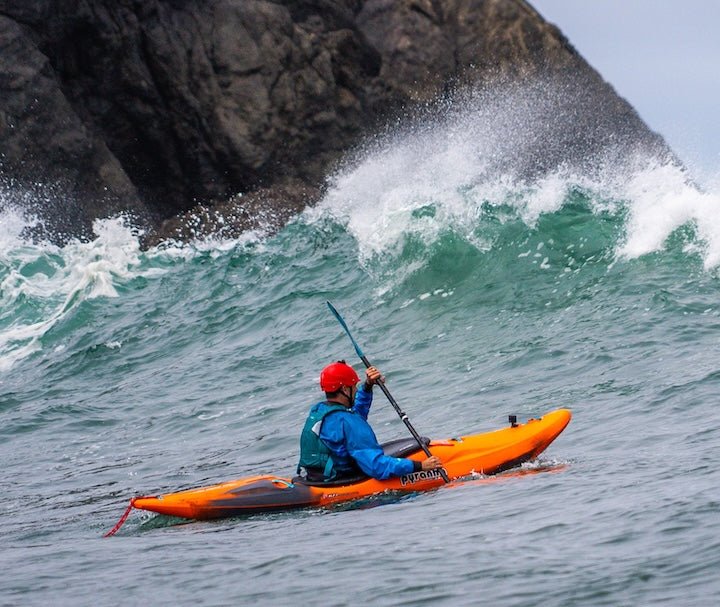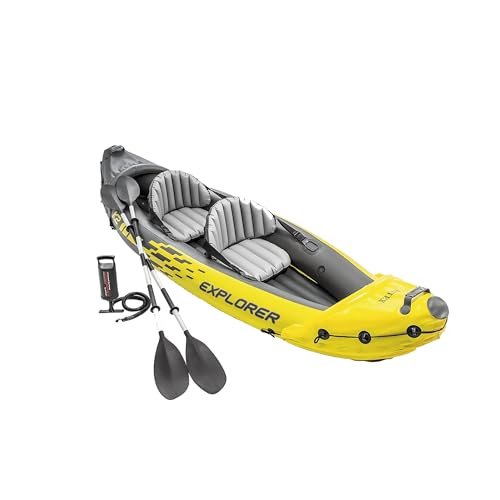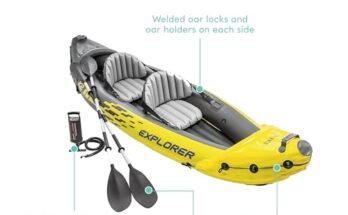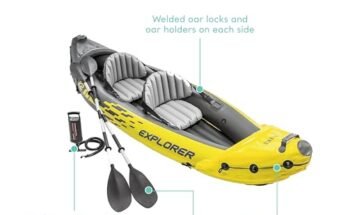Imagine yourself gliding smoothly over the ocean’s surface, the sun warming your skin and the sound of waves around you. Kayaking in the ocean is an exciting adventure that anyone can enjoy, but it’s important to know how to stay safe and make the most of your time on the water.
Whether you’re a complete beginner or looking to improve your skills, this guide will show you exactly how to kayak in the ocean with confidence. By the end, you’ll feel ready to paddle out and experience the thrill of ocean kayaking like never before.
Ready to dive in? Let’s get started!

Choosing The Right Kayak
Kayaking in the ocean is fun but needs the right kayak. Picking the right one keeps you safe and comfortable.
There are many kayaks for ocean use. You should know their types, size, and gear to have a good trip.
Types Of Ocean Kayaks
Ocean kayaks come in different styles. Each style fits certain water conditions and paddling needs.
- Touring kayaks: Long and narrow for speed and distance
- Sit-on-top kayaks: Easy to get on and off, good for warm weather
- Inflatable kayaks: Lightweight and easy to carry, but less stable in rough water
- Sea kayaks: Designed for waves and rough ocean, often with storage compartments
Kayak Size And Stability
Size affects how the kayak moves and feels in water. Stability is key for safety on ocean waves.
Long kayaks go faster but can be hard to turn. Wide kayaks stay steady but move slower.
- Length: Longer kayaks track better and cover more distance
- Width: Wider kayaks offer better balance and less tipping
- Weight capacity: Choose a kayak that holds your weight plus gear
- Hull shape: Rounded hulls are stable; V-shaped hulls cut through waves
Essential Gear For Ocean Kayaking
Having the right gear makes ocean kayaking safer and more enjoyable. Some gear is needed for every trip.
- Personal flotation device (PFD) for safety
- Spray skirt to keep water out of the kayak
- Paddle leash to prevent losing your paddle
- Dry bags to keep clothes and food dry
- Whistle or signaling device for emergencies
- Proper clothing for weather and water temperature
Preparing For Ocean Conditions
Kayaking in the ocean is exciting but can be challenging. You must prepare well to stay safe and enjoy your trip.
Knowing the ocean conditions helps you avoid risks like strong waves and currents. Preparation starts with understanding the weather and tides.
Reading Weather And Tides
Check the weather forecast before you go kayaking. Look for wind speed, temperature, and chance of rain. Calm weather is best for ocean kayaking.
Tides change water levels and affect waves. Know the time of high and low tides. This helps you plan safe entry and exit points.
- Use local tide charts or apps
- Understand high and low tide times
- Avoid kayaking during strong tide changes
Understanding Ocean Currents
Ocean currents can push your kayak off course. Some currents are strong and dangerous. Learn how to spot and avoid them.
Currents often flow along the coast or around islands. Paddle with the current to save energy and keep control.
- Ask local experts about currents
- Check maps showing current directions
- Practice paddling against mild currents first
Checking Safety Alerts
Before kayaking, check for safety alerts. These can warn you about hazards like storms, sharks, or water pollution.
Use official websites or local stations to find current safety information. Avoid kayaking if there are warnings.
- Watch for weather warnings
- Check for marine hazard alerts
- Follow advice from coast guards or park services
Safety Equipment Essentials
Kayaking in the ocean can be fun but also risky. Safety equipment keeps you safe and prepared.
Make sure to have the right gear before you start your ocean adventure.
Life Jackets And Personal Flotation Devices
Always wear a life jacket or personal flotation device (PFD) while kayaking. It helps keep you afloat in water.
Choose a PFD that fits well and is approved for ocean use. Check straps and zippers before each trip.
- Wear a Coast Guard-approved PFD
- Pick a size that fits snugly
- Check for damage or wear
- Use PFDs designed for ocean conditions
Communication Devices
Communication devices help you call for help if needed. They keep you connected on the water.
Carry a waterproof radio or a fully charged cell phone in a dry bag. A whistle or signal mirror can also alert others.
- Waterproof VHF radio for marine communication
- Cell phone in a waterproof case
- Whistle for sound signaling
- Signal mirror to catch attention
Emergency Kits And Tools
Emergency kits help you handle small injuries or problems during your trip. Tools keep your kayak working well.
Bring a first aid kit, paddle repair tools, and extra paddle. Include waterproof matches or a lighter for emergencies.
- Compact first aid kit with bandages and antiseptics
- Spare paddle or paddle repair kit
- Waterproof flashlight or headlamp
- Waterproof matches or lighter
- Knife or multi-tool for repairs

Basic Ocean Kayaking Techniques
Kayaking in the ocean needs skill and care. You must learn to control your kayak safely.
These techniques help you paddle well, handle waves, and move through currents with ease.
Paddling Efficiently
Good paddling saves energy and keeps you moving forward. Use smooth, even strokes on both sides.
- Keep your back straight and use your core muscles.
- Reach forward with your paddle, then pull it back through the water.
- Switch sides regularly to keep balance and go straight.
- Use your torso to turn, not just your arms.
- Keep your paddle close to the kayak to avoid splashing.
Handling Waves And Swells
Ocean waves can push your kayak off course. Face waves head-on to stay stable.
| Wave Type | How to Handle |
|---|---|
| Small Waves | Keep paddling steadily and stay upright. |
| Large Waves | Turn kayak to face waves directly; brace paddle for support. |
| Swells | Use long, smooth strokes and keep balanced. |
Navigating Currents
Currents can pull you away from your path. Plan your route to cross currents at an angle.
- Check current direction before you start.
- Angle your kayak slightly upstream to avoid drifting.
- Use stronger paddle strokes against the current.
- Rest on calm spots when possible to save energy.
- Always watch for changes in water flow.
Launching And Landing Safely
Kayaking in the ocean offers great fun and exercise. Launching and landing safely is very important.
Understanding how to pick launch spots and handle surf helps keep you safe on the water.
Choosing Launch Points
Pick a place with calm water and easy access to the ocean. Avoid rocky or slippery spots.
Look for beaches with gentle slopes. Check local weather and tides before launching.
- Find sandy or pebbly shorelines
- Avoid steep drop-offs or strong currents
- Stay away from boat traffic areas
- Use launch spots known for safe entry
Dealing With Surf Zones
Surf zones can be tricky. Waves push you back or tip your kayak if you are not ready.
Watch the waves for a while. Time your launch to go out between waves when the water is calmer.
- Keep your kayak pointed at the waves
- Paddle hard to pass through breaking waves
- Stay low to keep balance
- If you fall, hold on to your paddle and kayak
Safe Landing Practices
Landing safely is as important as launching. Approach the shore slowly and watch for waves.
Use your paddle to steer and slow down. Exit your kayak in shallow water or where the beach is easy to walk on.
- Face your kayak toward the shore
- Keep your paddle ready for balance
- Wait for a small wave to come in
- Step out carefully when water is shallow
Group Kayaking And Buddy System
Kayaking in the ocean is exciting but can be challenging. Going with a group or a buddy makes it safer and more fun.
A buddy system ensures you have someone watching your back. Group kayaking builds teamwork and enhances the adventure.
Benefits Of Kayaking With Others
Kayaking with others offers many advantages. You can share experiences and learn from each other.
Being in a group improves safety and makes the journey more enjoyable. You have people to rely on if you face challenges.
- Enhanced safety with more eyes on the water
- Shared experiences build friendships
- Motivation and support from teammates
Communication Signals
Communication is crucial when kayaking in a group. Knowing signals helps keep everyone informed and safe.
Hand signals work well when voices cannot be heard. Agree on signals before starting your trip.
- Use hand waves to signal stop
- Pointing means look in that direction
- Raising a paddle signals help needed
Staying Together
Staying together in a group is important. It helps with safety and makes the experience more enjoyable.
Keep a comfortable pace so everyone can keep up. Regularly check on each other to maintain group integrity.
- Maintain visual contact with your buddy
- Pause frequently to regroup
- Adjust pace to suit all members
Environmental Awareness
Kayaking in the ocean is an amazing adventure. It is important to be aware of the environment. Protecting the ocean ensures it stays beautiful for future generations.
Understanding the impact of our actions helps keep marine life safe. We can enjoy the ocean while being responsible caretakers of the environment.
Protecting Marine Life
Marine life is sensitive to human activities. Kayakers should maintain a safe distance from animals. Avoid touching or feeding them to prevent harm.
Be aware of your surroundings. Watch for marine life and avoid disrupting their habitats. Respect the ocean as their home.
- Keep a distance from animals
- Do not feed marine life
- Avoid areas marked as sensitive habitats
Leave No Trace Principles
Leaving no trace ensures the ocean remains clean. Take all trash with you when you leave. This prevents pollution and protects marine life.
Use biodegradable products to reduce impact. Keep the ocean as you found it. Practice these principles every time you kayak.
- Carry out all trash
- Use biodegradable products
- Respect nature
Respecting Local Regulations
Each area may have different rules. Learn about local regulations before kayaking. These rules protect the environment and ensure safety.
Follow signs and guidelines. Obeying these rules shows respect for the community and the ocean. It also helps preserve the beauty of natural sites.
- Know local rules
- Follow signs and guidelines
- Respect community efforts

Handling Emergencies
Kayaking in the ocean can be exciting and challenging. Emergencies may happen at any time. Knowing how to handle them keeps you safe on the water.
This guide covers key skills for dealing with emergencies. Learn how to rescue yourself, help others, and decide when to get outside help.
Self-rescue Techniques
If your kayak capsizes, stay calm and hold onto your paddle. Try to get back on your kayak or swim to shore if needed.
- Hold your paddle firmly above the water.
- Flip your kayak upright if possible.
- Climb back into the kayak from the side.
- If you cannot get back in, swim to shore with your kayak.
Assisting Others
Helping others during an emergency needs care. Approach calmly and offer your paddle or kayak for support.
| Action | Description |
|---|---|
| Approach Slowly | Get close without causing more waves or danger. |
| Offer Support | Extend your paddle or kayak for them to hold on. |
| Pull to Safety | Help them climb into your kayak or guide them to shore. |
| Call for Help | If needed, alert nearby kayakers or rescue teams. |
When To Call For Help
Call for help if you or others are injured or cannot reach shore. Use a whistle, radio, or phone to signal distress.
- Serious injuries like broken bones or bleeding
- Strong currents or waves pushing you away from shore
- Capsized kayak with no way to self-rescue
- Lost or disoriented in poor weather or fog
- Other kayakers in danger nearby
Frequently Asked Questions
What Safety Gear Is Essential For Ocean Kayaking?
Wearing a life jacket is crucial for ocean kayaking safety. A helmet and a whistle also help in emergencies. Bring a waterproof communication device. Always carry a first-aid kit and wear sun protection. Proper safety gear ensures a secure kayaking experience.
How Do You Handle Waves While Kayaking In The Ocean?
To handle ocean waves, paddle smoothly and maintain a balanced posture. Angle the kayak to face incoming waves head-on. Use your paddle to steer and stabilize. Avoid sudden movements to prevent capsizing. Practicing wave navigation improves control and safety.
What Skills Are Needed For Ocean Kayaking Beginners?
Beginners should learn paddling techniques, basic navigation, and self-rescue skills. Understanding tides and currents is important. Practice balance and steering in calm waters first. Taking a guided course can boost confidence. These skills ensure a safer and enjoyable ocean kayaking trip.
How To Choose The Right Kayak For Ocean Paddling?
Select a kayak designed for ocean use, usually longer and stable. Look for features like a rudder or skeg for control. Consider your weight and paddling style. Choose durable materials that resist saltwater damage. The right kayak enhances performance and safety.
Conclusion
Kayaking in the ocean brings great joy and fresh air. Always wear safety gear and check weather conditions first. Practice basic paddling skills on calm water before venturing out. Stay aware of waves, currents, and tides for a safe trip.
Enjoy the peaceful views and marine life around you. With patience and care, ocean kayaking becomes easier and more fun. Try to kayak with a friend or group for safety. Keep learning and exploring new places by kayak. This adventure builds confidence and connects you to nature.



